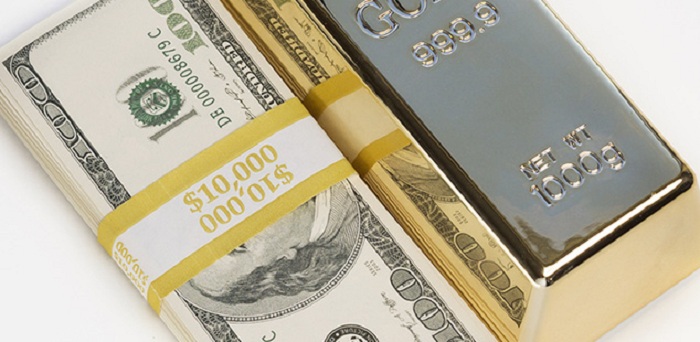Dollar extends Trump-trade rally as Gold declines with stocks

The catalyst is Donald Trump’s victory in the U.S. presidential election almost two weeks ago, and speculation the Federal Reserve will raise interest rates more rapidly than had previously been priced into financial markets. In her first public statement since the vote, Fed Chair Janet Yellen told lawmakers Thursday that the central bank is close to boosting borrowing costs. Speculation that Trump’s new administration will increase fiscal stimulus was already bolstering bets on further hikes in 2017.
“The dollar is rampant,” said Stuart Bennett, head of Group-of-10 currency strategy at Banco Santander SA in London. “It’s just this assumption, and for now it still is an assumption, that the U.S. is going to reflate next year from fiscal policy. Yellen’s comments yesterday probably helped the dollar.”
Currencies
The Bloomberg Dollar Spot Index, which tracks the greenback against 10 major peers, climbed 0.1 percent as of 7:08 a.m. New York time, extending this week’s rally to 1.6 percent. It traded at 110.15 yen per dollar and is up 6.9 percent over the past two weeks, the most for a similar period since 1999.
The U.S. currency added less than 0.1 percent to $1.0622 per euro, gaining for a 10th day.
Odds on the Fed raising the benchmark rate are now at 96 percent, up from 80 percent a week ago and less than 65 percent a month earlier, according to futures trading tracked by Bloomberg.
Malaysia’s ringgit retreated 0.6 percent as the nation’s central bank said it’s intervening in the currency market. China’s yuan slid to its weakest level since June 2008. India’s rupee weakened past 68 per dollar for the first time since June, while state-run banks sold dollars, probably on behalf of the Reserve Bank of India, two Mumbai-based traders said, asking not to be named.
Mexico’s peso fell 0.5 percent, extending Thursday’s losses, a sign that the central bank’s quarter-point increase in interest rates failed to restore investor confidence.
Bonds
The bond selloff deepened Friday, with yields on U.S., European and Asia-Pacific sovereign debt increasing. The Bloomberg Barclays Global Aggregate Index fell 4 percent from Friday Nov. 4 through Thursday. It’s the biggest two-week rout in the data, which go back to 1990.
Yields on Australia’s 10-year notes jumped 15 basis points to 2.72 percent. Yields on similar-maturity Treasuries increased one basis point to 2.31 percent, extending the eight basis-point jump last session, with similar moves seen in German and U.K. debt markets.
The cost of insuring highly rated corporate debt against default rose for the fourth day this week. The Markit iTraxx Europe Index of credit-default swaps on investment-grade companies rose two basis points to 82 basis points, the highest since July. The gauge has gained four basis points this week. An index of swaps on junk-rated companies rose seven basis points, the most this week, to 349 basis points.
Stocks
The Stoxx Europe 600 Index slipped 0.2 percent, paring its weekly advance to 0.7 percent, as mining companies fell with commodities prices.
Shippers and carmakers had led gains on the Topix index in Tokyo, which rose 0.4 percent. The Nikkei 225 closed at its highest level since January.
S&P 500 Index futures slipped 0.2 percent. Bank shares led the index to its highest level since Aug. 15 on Thursday, when the gauge reached an all-time high.
“Markets have arrived at a point where they need to weigh the risks of being caught out by the potential stimulatory impacts of the Trump administration’s policies, against the risk of being caught by those policies not being implemented,” Ric Spooner, chief market analyst in Sydney at CMC Markets, said in an e-mail.
Commodities
Gold tumbled to the lowest in more than five months, dropping as much as 1.1 percent to $1,202.96 an ounce. The precious metal has plunged as investors digested the implications of Trump’s policies, which may boost the economy and lead to higher borrowing costs. Rising bond yields and a stronger dollar are also weighing on gold, which doesn’t pay interest.
“It’s all about the dollar,” said David Govett, head of precious metals trading at Marex Spectron Group Ltd. in London. “I suspect we’ll see an 11 handle on gold today,” he said, referring to prices dropping below $1,200 an ounce.”
Oil futures slipped 0.4 percent in New York, weighed down by the stronger dollar that makes the fuel more expensive, even as some OPEC ministers held talks with Russia aimed at clinching an accord to stabilize markets.
Nickel fell 1.1 percent in London to lead declines by industrial metals. Copper retreated 0.6 percent, heading for a weekly loss after entering a bull market last week. The global glut in the metal used in cables and wiring will endure for another year in 2017, and it’s too early to know if the surprise price surge this month heralds a sustained trend, according to Ivan Arriagada, chief executive officer of Antofagasta Plc, one of Chile’s biggest producers.















































